With Innovation and Empathy, Remote Learning Becomes Accessible for All Students

The COVID-19 outbreak disrupted daily life for virtually every educator, parent, and student in the U.S. It has disabled our education system, creating challenges to educational access, barriers to student academic progress and strains on teachers’ and students’ physical and emotional well-being.
Social and emotional learning (SEL) can support us in reframing how we think about the challenges created by the pandemic and provide us with the tools we need to navigate those challenges effectively. In an earlier essay, we discussed how teachers are leaning into SEL to adapt student services and unlock opportunities that, just months ago, may have seemed impossible. Another major hurdle that the pandemic has presented relates to accessibility and understanding how remote learning works—or doesn’t work—for many of our most vulnerable students, particularly those with learning differences.